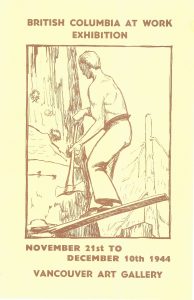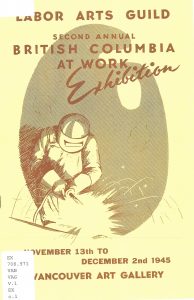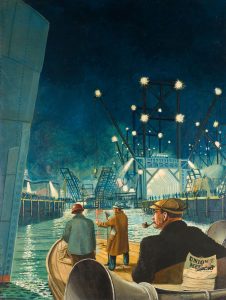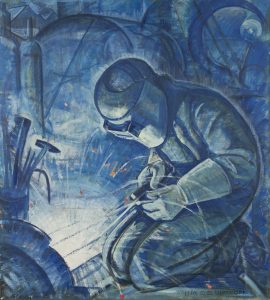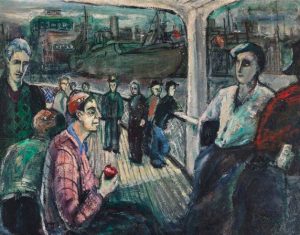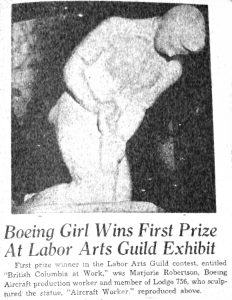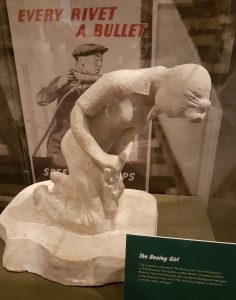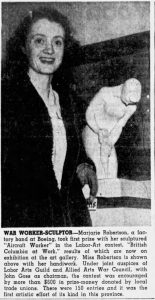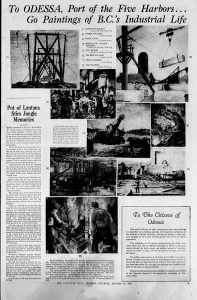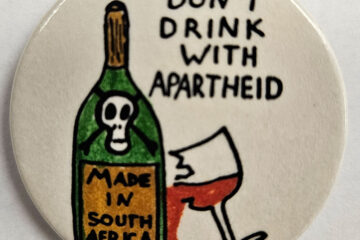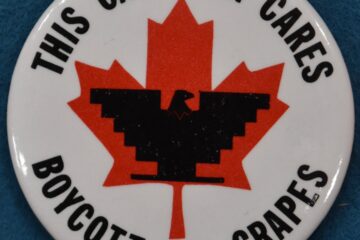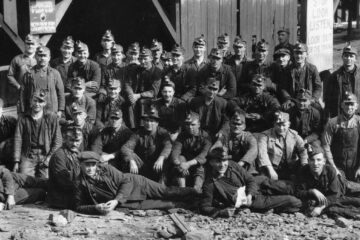The People Paint: BC Artists and the Victory of Democracy Over Fascism
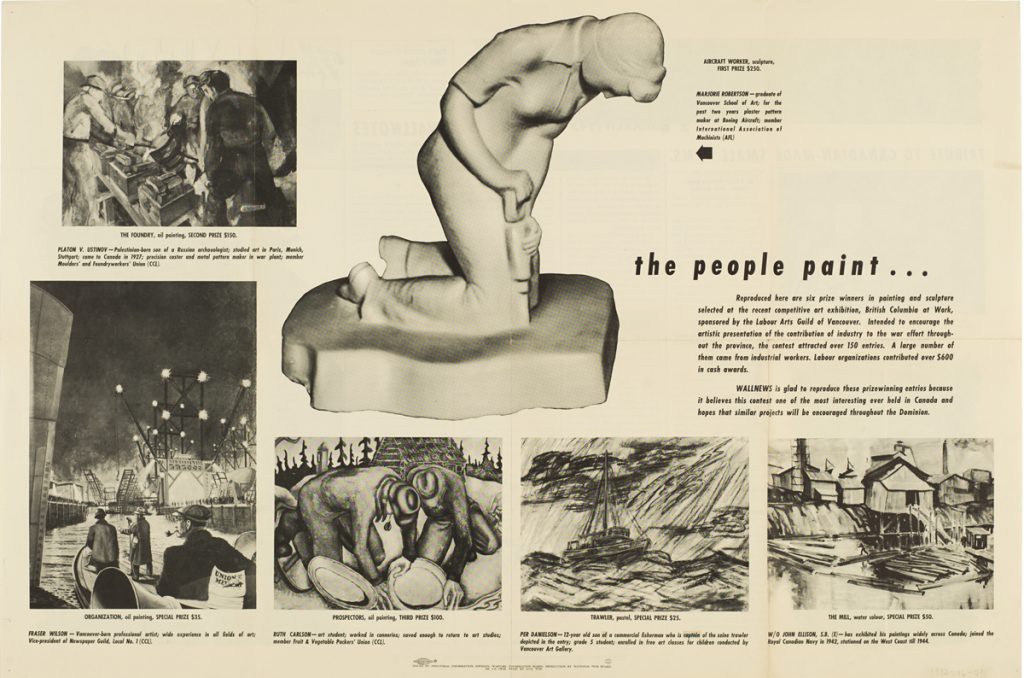
Poster promoting “British Columbia at Work”, WALL NEWS, MARCH 1945, Canadian War Museum, CWM 19920196-091.
by Donna Sacuta
The Labor Arts Guild: An Ambitious Wartime Project
In November 1944 and again in 1945 — as the Second World War neared its end — two art exhibitions celebrating labour took place at the Vancouver Art Gallery. The first exhibition included 150 works; in 1945 there were over 200 entries.
The exhibitions’ working titles began as “Labor in Wartime” evolved to “People at Work” but the final choice of “British Columbia at Work” stuck. 1
- Click to view 1944 catalogue.
- Click to view 1945 catalogue.
“British Columbia at Work” was mounted under the umbrella of the Allied Arts War Service Council and the Labor Arts Guild, an organization whose aims were “to mobilize and activize all artists, amateur and professional, who desire to identify their talents with the labor movement and progressive forces”. The sole criteria was to depict “some phase of economic activity…in which the connection of art and labour is featured”. 1
The Labor Arts Guild was co-founded in 1944 by John Goss, a musician and actor, and Julia Christianson, executive secretary of the Shipyard General Worker’s Federation. Both Goss and Christianson were active in the Labour Progressive Party, the political arm of Canadian communists. Read more about the cultural and political life of John Goss.
Women Workers
British Columbia’s industrial unions were large and powerful in the wartime economy. Shipyards employed over 30,000 unionized workers, many of them women who joined the workforce for the first time. Aircraft work, logging, mining and smelting jobs also attracted huge numbers of working men and women.
“British Columbia at Work” focused on the “industrial life of our Province…thereby stress[ing] the considerable and varied contribution made by our workers to the victory of Democracy over Fascism”, according to the 1945 exhibition guide. “This venture was unique in the history of Canadian art…and national recognition of this fact was recorded by the reproduction of the winning exhibits in the Wartime Information Board’s publication of “Wallnews” for March of this year.” 2
Watercolors, oils, sketches and sculptures depicted shipbuilding, canneries, agriculture and fishing. Both workers and industrial settings were included in the entries.
BC Unions Donate Prize Money
“British Columbia at Work” was supported by several BC unions, including the International Woodworkers of America (Local 1-71), the Shipyard General Workers’ Federation, and both Vancouver Labor Councils. Prize money was donated entirely by labour organizations, and four of the six winners in 1946 were members of unions.
Due to the war, the Vancouver Art Gallery had a skeleton staff of three employees, including the curator, and eagerly embraced the exhibit when it was proposed. The response from artists exceeded expectations. The 1944 exhibit had 150 entries and spread across two galleries. In 1945 there were over 200 works on display.
War Artists, Amateurs and Canadian Art Icons
“British Columbia at Work” attracted many artists from the Vancouver School of Art (now Emily Carr University) who became renowned names in the Canadian artistic community. They were artistic colleagues, and many went on to be lifelong friends.
Some of the exhibitors were current or past Canadian war artists. Notable names include Lieutenant Jack Shadbolt, Molly Lamb, Ina Uhthoff, Nan Lawson Cheney, Lilias Farley and Fraser Wilson.
Lawren Harris brought greetings from the Federation of Canadian Artists. Harris remarked “the painters have entered more fully into the life of the worker and into the drama and meaning of labor. It also amounts to a new movement in art in British Columbia.” 3
Artist B.C. Binning, Nigel Morgan of IWA Local 1-71 and Garry Culhane of the Shipyard General Workers’ Federation served as judges.
“British Columbia at Work” purposefully embraced both professional and amateur artists. “Part of our task will be to dissipate the snobbery about the arts which has grown up in the past and from which labor naturally withdraws”, according to Goss. 4
Per Danielson, the 12-year old son of a commercial fisherman entered a pastel drawing of a fishing trawler.
Vancouver artist Gordon Kit Thorne entered a pastel of men working in a factory titled “Night Shift”.
S. Trotzuk, a member of IWA Local 1-357 at Fraser Mills submitted three black-and-white sketches “Piling Lumber”, “Time Out” and “Planing Mill”.
- 756 Review (1944), UBC Rare Books and Special Collections
- “Aircraft Worker” is now in the Museum of Vancouver’s permanent collection.
- Vancouver Sun, 24 Nov 1944
First prize in 1944 went to Marjorie Robertson, a member of Lodge 756 of the International Association of Machinists and a Boeing Aircraft production worker, for her sculpture “Aircraft Worker”. The sculpture is in the Museum of Vancouver’s permanent collection.
Foundry Workers’ Union member Platon Ustinov’s oil painting “The Foundry” took second prize.
Fraser Wilson’s “Organization” depicting union organizing tactics in BC shipyards was part of the exhibit.
“End of Shift” a wood carving of a woman warworker by Lilias Farley won a $100 prize in 1945 and 15-year old Arnold Belkin’s oil painting “Workers on a Street Car” was named best oil painting.
Jack Shadbolt’s “Workers Going Home, Marpole Bridge” was given first prize for a watercolour.
Snubbed by Ottawa
The National Gallery of Canada in Ottawa declined to show the exhibit in 1945, replying to an offer from the Vancouver Gallery that “few of the artists are known to us”. 1
The new Boilermakers’ Union Hall on West Pender Street in Vancouver [which incidentally included “up-to-the-minute bowling alleys”] planned to host a special showing of “British Columbia at Work” for industrial workers in early 1945 .
From January to April 1946 a selection of the works toured the province, with exhibits held in Kamloops, Vernon, Kelowna, Nelson, Penticton, Trail, Kimberley, Creston, Alberni and Grand Forks where local artists were invited to participate.
Major Attraction in a Pioneering Field
Mainstream response to “British Columbia at Work” was effusive. “The vital nature of the subject matter and surprising number of talented artists, professional and amateur, contribute to a display which will undoubtedly rank among the general public as one of the Gallery’s major attractions of the year.” 5
The Machinists Union praised Marjorie Robertson’s win in 1944. “The $250 award came…at a very handy time for Miss Robertson, since it enables her to carry on an art course which would have otherwise been impossible.”
“The exhibit as a whole has received wide praise, not only for the quality of work submitted but also for its pioneering in a field which has so far been entirely neglected.” 6
Artwork Donated to Soviet City
Eight of the paintings from the 1944 exhibition were donated by Vancouver to its sister city Odessa as a “token of their high regard and profound admiration for a city and a people that have fought so valiantly in the cause of human freedom”. 7 It is unknown if the donation occurred, or if the paintings still exist. Ina Uhthoff’s “Girl Welder” is now in the collection of the Art Gallery of Greater Victoria, suggesting the donation did not come to fruition.
A Vanished Cultural Legacy
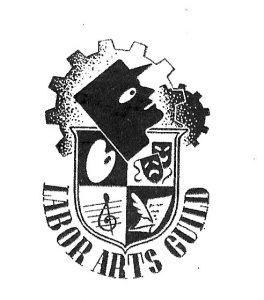 John Goss, Julia Christianson and the Labor Arts Guild were dedicated to connecting working people to the artistic world. In addition to the art exhibits they sponsored theatrical presentations such as Shakespeare’s Hamlet and well attended People’s Concerts featuring song, dance, classical and popular music. Goss and Christianson left Vancouver soon after “British Columbia at Work” finished in 1945. Their short but significant contribution to labour and the art world has been almost forgotten.
John Goss, Julia Christianson and the Labor Arts Guild were dedicated to connecting working people to the artistic world. In addition to the art exhibits they sponsored theatrical presentations such as Shakespeare’s Hamlet and well attended People’s Concerts featuring song, dance, classical and popular music. Goss and Christianson left Vancouver soon after “British Columbia at Work” finished in 1945. Their short but significant contribution to labour and the art world has been almost forgotten.
In 1982, the Vancouver Art Gallery curator attempted to locate some of the 350 pieces contained in the two exhibitions with limited success. Only a few are in public collections. Some were given to family members, sold privately or destroyed.
“British Columbia at Work” was an inspiration that merged art and trade unionism during a remarkable period in the province and its labour movement’s history. It is hard not to dream of the possibilities should a similar endeavour be undertaken today.
NOTE: For many years, the American spelling, labor, was predominant in the Canadian labour movement. We have used that spelling in the appropriate contexts.
We are grateful to the Vancouver Art Gallery Library and Archives for their assistance with research for this article.
- British Columbia at Work exhibition files, 1944 and 1945. Vancouver Art Gallery Archives[↩][↩][↩]
- British Columbia at Work exhibition file, 1945. Vancouver Art Gallery Archives[↩]
- Grand Forks Gazette, 31 Jan 1946[↩]
- Vancouver Sun, 5 July 1944[↩]
- The Province, 23 Nov 1944[↩]
- 756 Review, 20 Oct 1944[↩]
- Vancouver Daily Province, 20 Jan 1945[↩]
